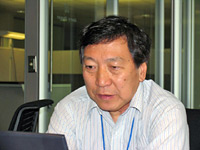Director's Corner
29 June 2006
 Barry Barish |
Sokendai Linear Collider Accelerator School
Not long after I became GDE Director, and even before I had recruited our initial design team, I gave a plenary talk on my ideas and plans for the ILC design effort at the Particle Accelerator Conference (PAC05) in Oak Ridge, Tennessee. While attending that conference, I was invited to a meeting of the ICFA Beam Dynamics Panel, chaired by Fermilab's Weiren Chou. We discussed the possibility of the GDE and the Beam Dynamics Panel co-sponsoring a linear collider accelerator school, and we would provide the lecturers. One year later, on 19-27 May 2006, we successfully held such an accelerator school in Sokendai, Hayama, Japan. (see NewsLine 1 June 2006).
 Weiren Chou reporting to the GDE Executive Committee following completion of the Sokendai Accelerator School. |
The path to becoming an accelerator physicist is not straight-forward. Accelerator schools not only provide enrichment for young accelerator physicists, they also play a central role in teaching future generations. Most universities do not have any accelerator physicists on their faculties, and therefore do not offer courses or PhD theses in the field. Most accelerator physicists have converted from other areas of experimental physics through learning at schools like Sokendai, and by on the job training at accelerator laboratories. Therefore, we felt obliged to sponsor the Sokendai School to help enhance the pipeline for young potential accelerator physicists.
I served as Sokendai organising committee chair, but the real driving forces behind this school were Weiren Chou and Shin-ichi Kurakowa (KEK), who was chair of the local organising committee and provided most of the logistics for the school. We aimed the school at PhD students, postdocs and young researchers, especially young experimentalists. It was generously supported by funding agencies and laboratories in Asia, Europe and the U.S., providing support for 72 students, as well as for 19 lecturers. An excellent example of successful global collaboration for the ILC, the school resulted from two years of Japanese efforts to host an accelerator school for linear colliders.
The curriculum consisted of an 8-day program, 6 days for lectures and 2 days for visiting and working on real machines at KEK. It covered both basic and advanced topics with the focus on accelerators, but also with lectures on detector concepts and physics. The curriculum committee recruited a first-class set of lecturers from the linear collider community, many of whom are very busy GDE members.
By any measure, the school was a spectacular success. Interest in the school was very high with over 500 applicants for 72 places, and the set of lectures were well organised and excellent. This success is also due in part to Fermilab's Cynthia Sazama and KEK's Yoko Hayashi, who worked very hard to support the school, and we appreciate all of their efforts.
We also learned some lessons, for example that we were too demanding and gave too much homework, not giving students adequate time for informal contacts (or maybe even sleep!). There is a real need to develop young accelerator physicists, and we are now considering building on this success by planning a 2 nd linear collider accelerator school in either Europe or the U.S..
-- Barry Barish